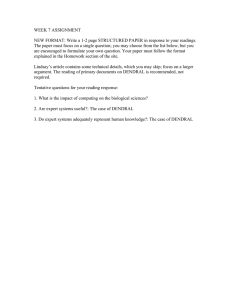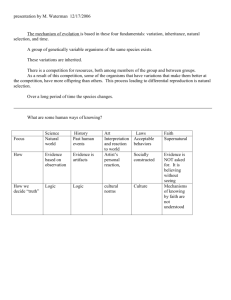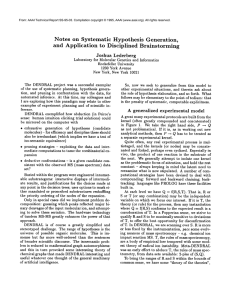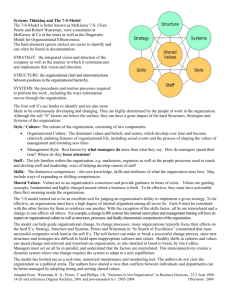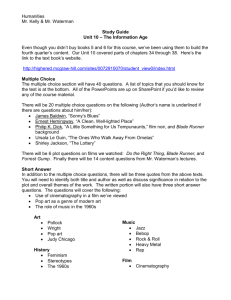ing that I considered of first ... e note with sorrow the passing of Don Waterman, ...
advertisement
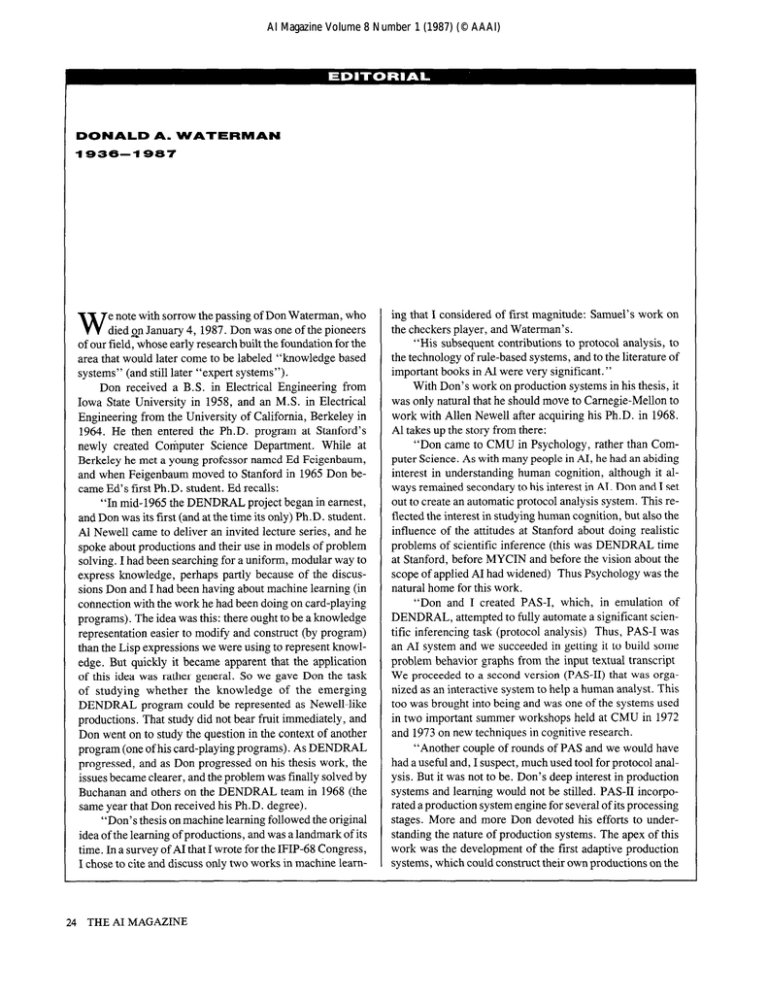
AI Magazine Volume 8 Number 1 (1987) (© AAAI) DONALD A. WATERMAN 1936-1967 e note with sorrow the passing of Don Waterman, who W diedgn January 4, 1987. Don was one of the pioneers of our field, whose early research built the foundation for the area that would later come to be labeled “knowledge based systems” (and still later “expert systems”). Don received a B.S. in Electrical Engineering from Iowa State University in 1958, and an M.S. in Electrical Engineering from the University of California, Berkeley in 1964. He then entered the Ph.D. program at Stanford’s newly created Cotiputer Science Department. While at Berkeley he met a young professor named Ed Feigenbaum, and when Feigenbaum moved to Stanford in 1965 Don became Ed’s first Ph.D. student. Ed recalls: “In mid-1965 the DENDRAL project began in earnest, and Don was its first (and at the time its only) Ph.D. student. Al Newell came to deliver an invited lecture series, and he spoke about productions and their use in models of problem solving. I had been searching for a uniform, modular way to express knowledge, perhaps partly because of the discussions Don and I had been having about machine learning (in coimection with the work he had been doing on card-playing programs). The idea was this: there ought to be a knowledge representation easier to modify and construct (hy program) than the Lisp expressions we were using to represent knowledge. But quickly it became apparent that the application of this idea was rather general. So we gave Don the task of studying whether the knowledge of the emerging DENDRAL program could be represented as Newell-like productions. That study did not bear fruit immediately, and Don went on to study the question in the context of another program (one of his card-playing programs). As DENDRAL progressed, and as Don progressed on his thesis work, the issuesbecame clearer, and the problem was finally solved by Buchanan and others on the DENDRAL team in 1968 (the same year that Don received his Ph. D . degree). “Don’s thesis on machine learning followed the original idea of the learning of productions, and was a landmark of its time. In a survey of AI that I wrote for the IFIP-68 Congress, I chose to cite and discuss only two works in machine learnI- 24 THE AI MAGAZINE ing that I considered of first magnitude: Samuel’s work on the checkers player, and Waterman’s. “His subsequent contributions to protocol analysis, to the technology of rule-based systems, and to the literature of important books in AI were very significant.” With Don’s work on production systems in his thesis, it was only natural that he should move to Carnegie-Mellon to work with Allen Newell after acquiring his Ph.D. in 1968. Al takes up the story from there: “Don came to CMU in Psychology, rather than Computer Science. As with many people in AI, he had an abiding interest in understanding human cognition, although it always remained secondary to his interest in AI. Don and I set out to create an automatic protocol analysis system. This reflected the interest in studying human cognition, but also the influence of the attitudes at Stanford about doing realistic problems of scientific inference (this was DENDRAL time at Stanford, before MYCIN and before the vision about the scope of applied AI had widened) Thus Psychology was the natural home for this work. “Don and I created PAS-I, which, in emulation of DENDRAL, attempted to fully automate a significant scientific inferencing task (protocol analysis) Thus, PAS-I was an AI system and we succeeded in getting it to build some problem behavior graphs from the input textual transcript We proceeded to a second version (PAS-II) that was organized as an interactive system to help a human analyst. This too was brought into being and was one of the systems used in two important summer workshops held at CMU in 1972 and 1973 on new techniques in cognitive research. “Another couple of rounds of PAS and we would have had a useful and, I suspect, much used tool for protocol analysis. But it was not to be. Don’s deep interest in production systems and learning would not be stilled. PAS-II incorporated a production system engine for several of its processing stages. More and more Don devoted his efforts to understanding the nature of production systems. The apex of this work was the development of the first adaptive production systems, which could construct their own productions on the fly, by means of a build-action. His neat demonstrations served to open up the whole field of machine learning. It now became possible to construct learning systems easily and in profusion, and with enough communality between them to permit scientific progress. Although for many years the expert systems field did not exploit the learning capabilities of productions, that is finally being rectified asthe learning systems research has matured. Don played a critical role in launching this whole area of research. ” In 1975, Don joined the Information Sciences Department at the Rand Corporation. For several years he worked closely with Rick Hayes-Roth: “ . . . his work focused on what came to be widely known as knowledge engineering, and expert systemsin partitular . His contributions there included: participation in the RITA and ROSIE language developments, with special emphasis on the use of these types of languages for heuristic modelling; ‘interactive letters,’ which used active agentsas a form of communication that could display itself as a letter, query the recipient, and automatically generate and re-send to the originator a response; exemplary programming, which provided an easy-to-use mechanism that looked over programmers’ shoulders to capture their stereotypic behaviors in the form of an intelligent agent that could be reapplied automatically when desired; and several important areas of expert systems, including naval threat assessment(TECA) and legal reasoning in the domain of civil liability. “Don helped organize milestone workshops on patterndirected inference systems and building expert systems. These resulted in two important books (with corresponding titles). Recently, he co-edited two other books, which compiled the major results of .&=Iresearch at RAND over the last decade, and which surveyed the field of expert systemsin the mid-eighties. “Don managed to predict the key areas of importance for the field of knowledge engineering usually several years before they were evident to others. If that weren’t enough, he also made significant contributions in every one of them.” Bob Anderson was Don’s supervisor and colleague at Rand. “It is hard to capture in a few words the essential qualities that made Don such a valued colleague,” saysBob “He had a quiet competence and thoroughness, tackling research, writing, editing, and other tasks until the job was done well. At age 50, he was at the peak of his productivity and expertise, acknowledged as a world expert in rule-based systems and their applications. He will be missed as a colleague and a friend. ” Don is the author, co-author, and co-editor of four books1*2,3,4 and over 40 technical papers and journal articles In addition, Don was the editor-in-chief of the journal, Expert Systems, and a member of the editorial boards of three other journals on expert systems To honor his achievements, and the early and influential part he played in the development of knowledge based systems, the Stanford Knowledge Systems Laboratory is establishing the Donald Waterman Memorial Reading Room for its graduate students. The KSL is grateful for the help given in this endeavor by Don’s wife Gloria and by the RAND Corporation In addition to his wife, Don leaves a sister and brother, four children and four grandchildren. Don’s family has askedthat any remembrancesbe made to an educational fund for their young daughter: The SusanWaterman Trust Fund. Contributions should be sent to the trust fund administrators, the law firm: Greene, Radovsky , Maloney and Share Spear Street Tower, Suite 3200 1 Market Plaza San Francisco, CA 94105 ‘Waterman, D A and Hayes-Roth, F (eds ) Pattern-Directed Inference Systems Academic Press, New York, 1978 2Hayes-Roth, R , Waterman, D A , and Lenat, D (eds ) Building Expert Systems Addison-Wesley, 1983 Translated into Japanese by Sangyo Tosho Publishing Company Translated into Russian by Mir Publishers awaterman, D A A Guide to Expert Systems Addison-Wesley, 1986 Being translated into Taiwanese by SoutheastBook Company Xlahr, P and Waterman, D A (eds ) Expert Systems: Techniques, Tools and Applications Addison-Wesley, 1986 (The AI Magazine thanks Robert Anderson, Edward Feigenbaum, Frederick Hayes-Roth and Allen Newell for their remembrances ) SPRING 1987 25
